人教版小学四年级英语上册表格式教案(完整版)
- 格式:docx
- 大小:563.63 KB
- 文档页数:101

人教版小学四年级英语上册全册教案第一教学方案教学目:1.能听懂、会: What's in the classroom? Aboard, two lights, many desks and chairs.并能在情景中运用。
2.能听、、本主要:classroom, window, door, picture, board, light,3.能听懂并能按照指令做事情。
教学重点:学 What's in the classroom? 及相关:classroom, window, door, picture, board, light。
教学点:1. window 一注意 w的音 , 不要与 v 的音混淆 , 教在教学中及正。
2.在回答 "What's in the classroom?", 注意复数的音。
教具准:1.教材相配套的教学件[Unit 1 Let's learn/A]2.教材相配套的教学音3.教自制的卡4.一画有教室的大教学程:(一)身、复(Warm-up / Revision)1.教播放第一册Recycle 1元中得"Chant and find"部分,学生跟着音一起。
2.教出示与 chant 内容相符的片 , : "What's in the picture?"学生行回答。
Picture一由里引出。
3.引学生用 pencil, ruler, bag, book, pencil-case, sharpener, eraser,crayon,pen 做答 , 如: What's in the bag? What's in the pencil-case ?(二)呈新( Presentation)1.教把一画有教室的大到黑板上, : This is a classroom. What's in the classroom?2.告学生我要学有关classroom 的内容 , 教 classroom3.学生看本部分的教学件 2 遍。
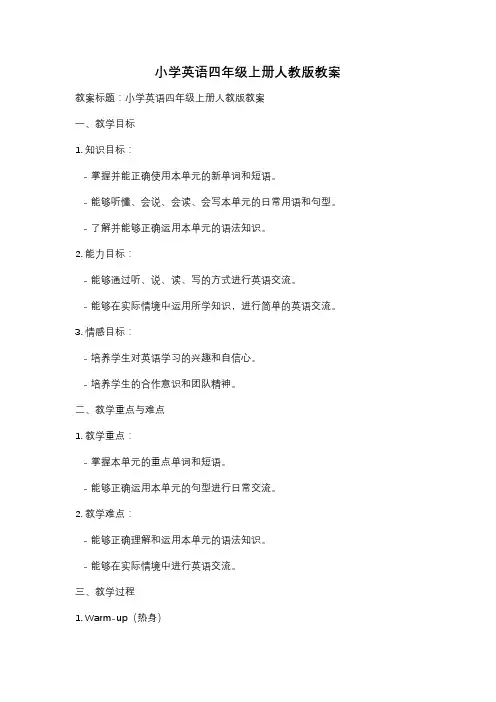
小学英语四年级上册人教版教案教案标题:小学英语四年级上册人教版教案一、教学目标1. 知识目标:- 掌握并能正确使用本单元的新单词和短语。
- 能够听懂、会说、会读、会写本单元的日常用语和句型。
- 了解并能够正确运用本单元的语法知识。
2. 能力目标:- 能够通过听、说、读、写的方式进行英语交流。
- 能够在实际情境中运用所学知识,进行简单的英语交流。
3. 情感目标:- 培养学生对英语学习的兴趣和自信心。
- 培养学生的合作意识和团队精神。
二、教学重点与难点1. 教学重点:- 掌握本单元的重点单词和短语。
- 能够正确运用本单元的句型进行日常交流。
2. 教学难点:- 能够正确理解和运用本单元的语法知识。
- 能够在实际情境中进行英语交流。
三、教学过程1. Warm-up(热身)- 利用图片或实物引出本单元的主题,并通过简单的问答方式激发学生的学习兴趣。
2. Presentation(呈现)- 通过教师的示范和引导,呈现本单元的新单词和短语,并进行语音、语调的训练。
3. Practice(练习)- 利用游戏、歌曲等形式,让学生在轻松愉快的氛围中进行单词和句型的练习。
4. Production(表达)- 让学生进行角色扮演、小组讨论等活动,运用所学知识进行实际交流。
5. Consolidation(巩固)- 通过练习册、作业等方式,巩固本单元的知识点。
6. Assessment(评估)- 利用听力、口语、书面等方式对学生进行评估,检查他们对本单元知识的掌握情况。
四、教学资源- 教材、多媒体课件、图片、实物等。
五、教学反思- 教师应根据学生的实际情况,灵活调整教学策略,确保教学效果。
同时,及时总结教学反思,不断提高教学质量。
以上是对小学英语四年级上册人教版教案的建议和指导,希朥对您有所帮助。
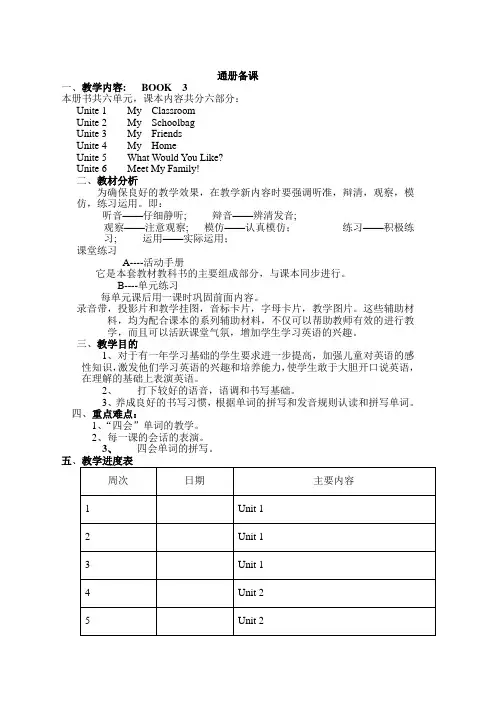
通册备课一、教学内容: BOOK 3本册书共六单元,课本内容共分六部分:Unite 1 My ClassroomUnite 2 My SchoolbagUnite 3 My FriendsUnite 4 My HomeUnite 5 What Would You Like?Unite 6 Meet My Family!二、教材分析为确保良好的教学效果,在教学新内容时要强调听准,辩清,观察,模仿,练习运用。
即:听音——仔细静听; 辩音——辨清发音;观察——注意观察; 模仿——认真模仿;练习——积极练习; 运用——实际运用;课堂练习A----活动手册它是本套教材教科书的主要组成部分,与课本同步进行。
B----单元练习每单元课后用一课时巩固前面内容。
录音带,投影片和教学挂图,音标卡片,字母卡片,教学图片。
这些辅助材料,均为配合课本的系列辅助材料,不仅可以帮助教师有效的进行教学,而且可以活跃课堂气氛,增加学生学习英语的兴趣。
三、教学目的1、对于有一年学习基础的学生要求进一步提高,加强儿童对英语的感性知识,激发他们学习英语的兴趣和培养能力,使学生敢于大胆开口说英语,在理解的基础上表演英语。
2、打下较好的语音,语调和书写基础。
3、养成良好的书写习惯,根据单词的拼写和发音规则认读和拼写单词。
四、重点难点:1、“四会”单词的教学。
2、每一课的会话的表演。
3、四会单词的拼写。
五一、教学内容1、本单元要求会听,说,认读的单词:window board light picture door floor classroom computerwall teacher’s desk fan what in the we have new go where2、本单元要求会听,说的单词和词组:many our seat near classmate cleanhave a look good idea all right good job3、帮助学生在掌握单词的基础上造出句子,编出对话,学以致用。
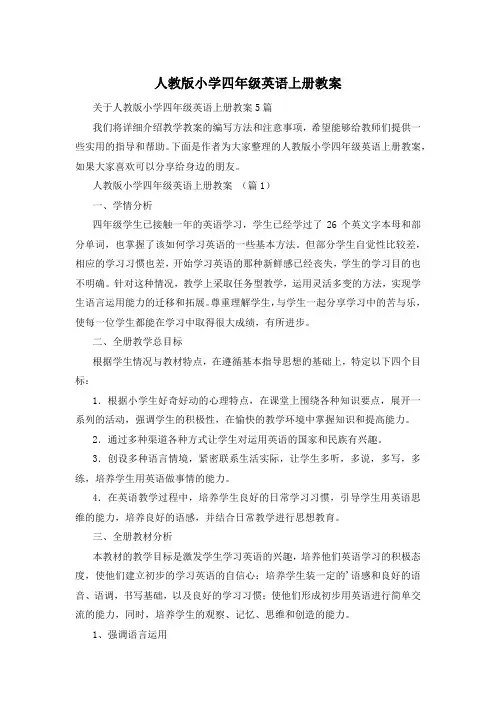
人教版小学四年级英语上册教案关于人教版小学四年级英语上册教案5篇我们将详细介绍教学教案的编写方法和注意事项,希望能够给教师们提供一些实用的指导和帮助。
下面是作者为大家整理的人教版小学四年级英语上册教案,如果大家喜欢可以分享给身边的朋友。
人教版小学四年级英语上册教案(篇1)一、学情分析四年级学生已接触一年的英语学习,学生已经学过了26个英文字本母和部分单词,也掌握了该如何学习英语的一些基本方法。
但部分学生自觉性比较差,相应的学习习惯也差,开始学习英语的那种新鲜感已经丧失,学生的学习目的也不明确。
针对这种情况,教学上采取任务型教学,运用灵活多变的方法,实现学生语言运用能力的迁移和拓展。
尊重理解学生,与学生一起分享学习中的苦与乐,使每一位学生都能在学习中取得很大成绩,有所进步。
二、全册教学总目标根据学生情况与教材特点,在遵循基本指导思想的基础上,特定以下四个目标:1.根据小学生好奇好动的心理特点,在课堂上围绕各种知识要点,展开一系列的活动,强调学生的积极性,在愉快的教学环境中掌握知识和提高能力。
2.通过多种渠道各种方式让学生对运用英语的国家和民族有兴趣。
3.创设多种语言情境,紧密联系生活实际,让学生多听,多说,多写,多练,培养学生用英语做事情的能力。
4.在英语教学过程中,培养学生良好的日常学习习惯,引导学生用英语思维的能力,培养良好的语感,并结合日常教学进行思想教育。
三、全册教材分析本教材的教学目标是激发学生学习英语的兴趣,培养他们英语学习的积极态度,使他们建立初步的学习英语的自信心;培养学生装一定的'语感和良好的语音、语调,书写基础,以及良好的学习习惯;使他们形成初步用英语进行简单交流的能力,同时,培养学生的观察、记忆、思维和创造的能力。
1、强调语言运用本教材吸收了交际教学思想,注重学生语言应用能力的培养。
在整体构思、内容安排、活动设计和教学方法选用等方面都紧密联系学生的生活实际,体现语言的交际功能,把话题#功能#结构#任务结合起来,并根据学生的年龄特点,采用“全部动作反应法”让学生在有节奏的说唱中体验语言。
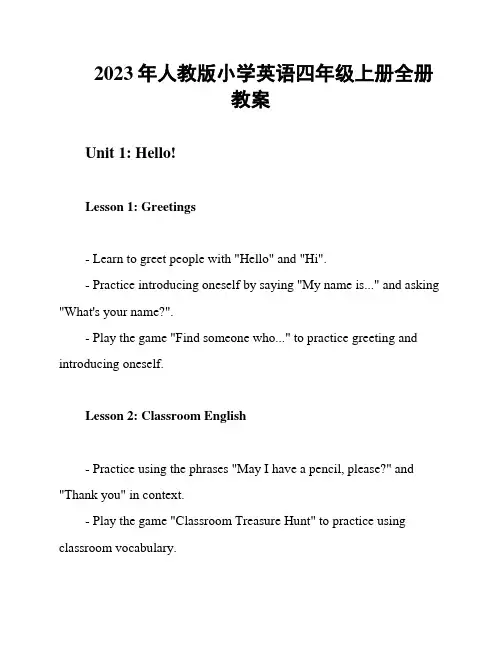
2023年人教版小学英语四年级上册全册教案Unit 1: Hello!Lesson 1: Greetings- Learn to greet people with "Hello" and "Hi".- Practice introducing oneself by saying "My name is..." and asking "What's your name?".- Play the game "Find someone who..." to practice greeting and introducing oneself.Lesson 2: Classroom English- Practice using the phrases "May I have a pencil, please?" and "Thank you" in context.- Play the game "Classroom Treasure Hunt" to practice using classroom vocabulary.Unit 2: FamilyLesson 1: Family Members- Learn vocabulary for family members such as father, mother, brother, sister, and grandparents.- Practice identifying family members in pictures.- Play the game "Family Bingo" to review family member vocabulary.Lesson 2: Family Activities- Learn vocabulary for family activities such as eat, play, and watch TV.- Practice using the phrases "My family likes to..." and "I like to..." in context.- Play the game "Family Charades" to practice family activity vocabulary.Unit 3: Food and DrinksLesson 1: Food Vocabulary- Practice identifying foods in pictures.- Play the game "Food Memory" to review food vocabulary.Lesson 2: Ordering Food- Learn phrases for ordering food such as "I want..." and "Can I have...?".- Practice ordering food in context.- Play the game "Restaurant Role Play" to practice ordering food vocabulary.Unit 4: AnimalsLesson 1: Animal Vocabulary- Practice identifying animals in pictures.- Play the game "Animal Charades" to review animal vocabulary.Lesson 2: Animal Sounds- Learn the sounds that animals make.- Practice matching animals with their sounds.- Play the game "Animal Sound Bingo" to review animal sounds.Unit 5: SportsLesson 1: Sports Vocabulary- Practice identifying sports in pictures.- Play the game "Sports Memory" to review sports vocabulary.Lesson 2: My Favorite Sport- Learn how to express one's favorite sport using the phrase "My favorite sport is...".- Practice talking about one's favorite sport in context.- Play the game "Sport Survey" to practice talking about favorite sports.Unit 6: Seasons and WeatherLesson 1: Seasons Vocabulary- Learn vocabulary for the four seasons and weather such as sunny, rainy, windy, and snowy.- Practice identifying seasons and weather in pictures.- Play the game "Seasons and Weather Memory" to review seasons and weather vocabulary.Lesson 2: Weather Report- Learn phrases for talking about the weather such as "It's sunny today" and "It's raining outside".- Practice giving a weather report in context.- Play the game "Weather Reporter" to practice weather vocabulary.以上就是小学四年级上册的教案内容。
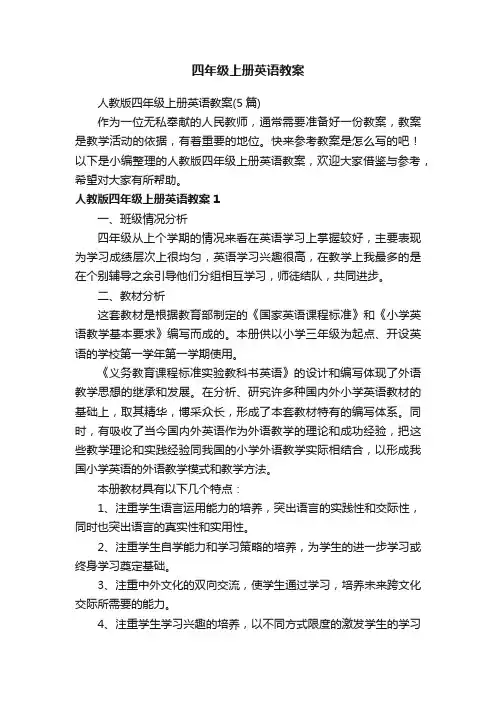
四年级上册英语教案人教版四年级上册英语教案(5篇)作为一位无私奉献的人民教师,通常需要准备好一份教案,教案是教学活动的依据,有着重要的地位。
快来参考教案是怎么写的吧!以下是小编整理的人教版四年级上册英语教案,欢迎大家借鉴与参考,希望对大家有所帮助。
人教版四年级上册英语教案1一、班级情况分析四年级从上个学期的情况来看在英语学习上掌握较好,主要表现为学习成绩层次上很均匀,英语学习兴趣很高,在教学上我最多的是在个别辅导之余引导他们分组相互学习,师徒结队,共同进步。
二、教材分析这套教材是根据教育部制定的《国家英语课程标准》和《小学英语教学基本要求》编写而成的。
本册供以小学三年级为起点、开设英语的学校第一学年第一学期使用。
《义务教育课程标准实验教科书英语》的设计和编写体现了外语教学思想的继承和发展。
在分析、研究许多种国内外小学英语教材的基础上,取其精华,博采众长,形成了本套教材特有的编写体系。
同时,有吸收了当今国内外英语作为外语教学的理论和成功经验,把这些教学理论和实践经验同我国的小学外语教学实际相结合,以形成我国小学英语的外语教学模式和教学方法。
本册教材具有以下几个特点:1、注重学生语言运用能力的培养,突出语言的实践性和交际性,同时也突出语言的真实性和实用性。
2、注重学生自学能力和学习策略的培养,为学生的进一步学习或终身学习奠定基础。
3、注重中外文化的双向交流,使学生通过学习,培养未来跨文化交际所需要的能力。
4、注重学生学习兴趣的培养,以不同方式限度的激发学生的学习动机。
5、注重融合学科内容,加强学科之间的整合和渗透,让学生通过英语学习来获得其他学科的知识。
6、注重教材的灵活性和可操作性,以满足不同层次的学生的需求。
7、注重教学资料的配套,为学生提供良好的英语学习环境,帮助学生拓展自我发展的空间。
8、注重中小学各阶段的衔接,以保证各学段的顺利过渡,全面提高中小学英语教学的整体质量。
三、教学目的1、激发学生学习英语的兴趣,培养他们学习英语的积极态度,使他们初步建立学习英语的自信心。
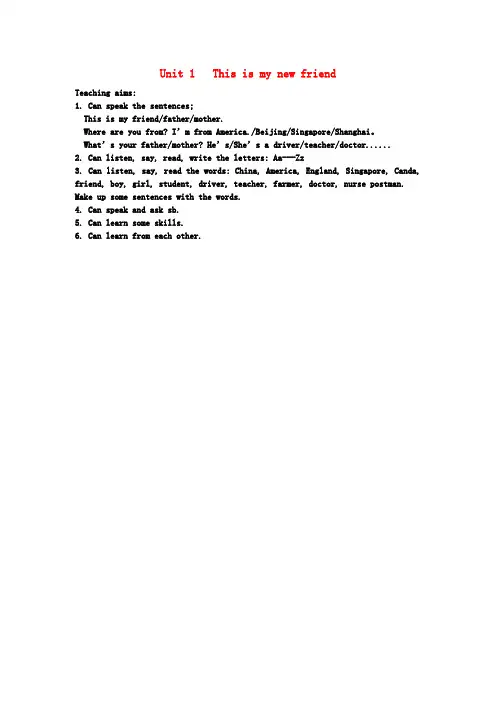
Unit 1 This is my new friendTeaching aims:1. Can speak the sentences;This is my friend/father/mother.Where are you from? I’m from America./Beijing/Singapore/Shanghai。
What’s your father/mother? He’s/She’s a driver/teacher/doctor......2. Can listen, say, read, write the letters: Aa---Zz3. Can listen, say, read the words: China, America, England, Singapore, Canda, friend, boy, girl, student, driver, teacher, farmer, doctor, nurse postman. Make up some sentences with the words.4. Can speak and ask sb.5. Can learn some skills.6. Can learn from each other.Unit 1. This is my new friend.Lesson OneTeaching aims:1. To learn the new words and letters;2. To learn the new sentences3. To use the patterns in the real situations.Main point: the new words and letters and sentences.Difficult point: make up a new dialogue.Teaching aids: the tape recorder and pictures.Teaching steps:Step 1: warm-up1) Look at the letter and read them;2) Say some old words;3)Make up some sentences with “This is...”Step 2: presentation1) Teacher says: New term is beginning. Let’s send your regards to your classmates. Ss : Hi! ( Nice to meet you.)2) T: This is my new friend. She’s from America.Ss: This is ......3) Look at the pictures and say them; Listen to the recording and repeat.4) To learn the new words: China America EnglandThis is my new friend. She’s/He’s from......5) To learn the letters: a b c d eStep 3: practice1) Ask and answer: Where are you from? I’m from......2) Guessing gameStep 4: assessment1) Read the letters2) Introduce their friends3) Read the new words4) Listening gameStep 5: additional activities1) Use the old sentences make up some new ones2) Say some wordsWriting on the blackboard:Lesson OneChina America EnglandAa Bb Cc Dd EeSummary:Lesson TwoTeaching aims:1.To learn the new words and letters: Singapore Canada friends2.To learn the new dialogue: Where’re you from? I’m from……We’re good friends.Main points: the new words, letters, sentences.Difficult points: the new dialogue.Teaching aids: the tape-recorder and pictures.Teaching steps:Step 1: Revision1)Ask and answer: Where are you from? I’m from……2)Read some lettersStep 2: Presentation1)Show them the flags: China America English Singapore Canada2)Ask and answer one by one: Where are you from? I’m from……3)Listen to the tape recorder again and again, read after it.4)To learn the new words: Singapore Canada friends5)To learn the new letters: Ff Gg Hh Ii JjStep 3: Practice1)Play a game: say the words quickly2)Sing a song: Where are you from?Step 4: Assessment1)Look at the pictures and say them2)Act out the dialogueStep 5: Additional activities1)Draw some flags2)Sing the songWriting on the blackboard:Lesson TwoSingapore Canada friendsFf Gg Hh Ii JjSummary:Lesson ThreeTeaching aims:1. To learn the new words and letters: boy girl student2. To learn the new dialogue: Come on, boys.Have some fruit.Who’s this boy?.Main points: the new words, letters, sentences.Difficult points: the new dialogue.Teaching aids: the tape-recorder and pictures.Teaching steps:Step 1: Revision1)Sing the song: Where are you from?2)Act out the old lesson3)Ask and answerStep 2: Presentation1)Review some animals:Ask and answer: S: Mum, this is my new friend, kangaroo.Mum: Hi, kangaroo, where are you from?Kangaroo: I’m from Australia.2)To learn the new words: boy girl student3)To learn the new sentences: Come on, boys.Have some fruit. ( apples, bananas……)4)Listen to the tape-recorder and repeat5)To learn the new letters: Kk Ll Mm Nn OoStep 3: Practice1)Guessing game: Who’s this boy? Who’s this girl?2)Boy or girlStep 4: Assessment1)Look at the pictures and say2)Make up a new dialogue3)Who’s…Step 5: Additional activities1)Have …… OK. Here you are.2)Tell their parents the new words.Writing on the blackboard:Lesson Threeboy girl studentKk Ll Mm Nn OoSummary:Lesson FourTeaching aims:1.To learn the new words and letters: driver teacher farmer2.To learn the new dialogue: What’s your father? He’s a driver.Main points: the new words, letters, sentences.Difficult points: the new dialogue.Teaching aids: the tape-recorder and pictures.Teaching steps:Step 1: Revision1) Sing the song: Where are you from?2)Play a game: What’s missing?3)Ask and answerStep 2: Presentation1)Look at the photo: T: Who’s that boy?S: It’s me. This is my father.T: He’s cool.2)Listen to the tape-recorder again and again. Ask the students to tell them whatabout it.3)Read after the tape-recorder4)To learn the new words5)To learn the new lettersStep 3: Practice1)Guessing game2)Ask and answer one by oneStep 4: Assessment1)Guess: Who is he/she?2)Make up new dialoguesStep 5: Additional activitiesLook at the photo and make up a new dialogue.Writing on the blackboard:Lesson Fourteacher driver farmerPp Qq Rr Ss TtSummary:Lesson FiveTeaching aims:1. To learn the new words and letters: doctor nurse postman2. To learn the sentence: She is beautiful.Main points: the new words, letters, sentences.Difficult points: the new dialogue.Teaching aids: the tape-recorder and pictures.Teaching steps:Step 1: Revision1)Act out the dialogue2)Guessing gameStep 2: Presentation1)What will you be when you grow up? ( doctor teacher driver farmer…)2)To learn the new words: doctor nurse postman ( Read them again and again.)3)Look at the pictures and listen. Read after it again and again.4)Act out the dialogue5)To learn the new letters: Uu Vv Ww Xx Yy ZzStep 3: Practice1) Guessing game2) Finding game3) Draw some picturesStep 4: Assessment1)Ask and answer: What’s your …? She/ He’s …2)Read the words quicklyStep 5: Additional activities1)Listen to the tape-recorder and make up a new dialogue2)Review the wordsWriting on the blackboard:Lesson Fivedoctor nurse postmanUu Vv Ww Xx Yy ZzSummary:Lesson SixTeaching aims:1. To learn the new words :TV reporter policeman2. To learn the new dialogue: My mum is a TV reporter. Be careful. Your fatheris a policeman.Main points: the new words, letters, sentences.Difficult points: the new dialogue.Teaching aids: the tape-recorder and pictures.Teaching steps:Step 1: Revision1)Look and say: pupil, teacher, doctor, policeman, farmer, nurse, postman, driver2)I’m from……( China America England Singapore Canada )Step 2: Presentation1)To learn the new words: TV reporter policeman2)Listen to the tape-recorder again and again. Read after it again and again.3)Word in groups. Act out the dialogueStep 3: Practice1)Guessing game2)Say some countriesStep 4: Assessment1)Act the dialogue out in groups2)Listen and do3)Review the wordsStep 5: Additional activities1)Say some words2)Read the dialogue and actWriting on the blackboard:Lesson SixTV reporter policemanSummary:Lesson 7Teaching aims:1 Learn the news words: three four class grade2 Learn the new dialogueImportance teaching aims:1 .The sentences: what class are you in? I’m in clas s two, grade three.2 .Act the dialogueTeaching steps:Step 1:Revision1. Sing number song2. Revise 26 letters.Step 2, Presentation1. Learn the words: one, two, three, four, five,2. Write the words3. class~~ grade~~4, Learn the dialogue5. Act the dialogueDisignLesson 7What class are you in?I’m in class two, grade three.Lesson 8Teaching aims:1Learn the news words: thirteen, fourteen, three, four2 Learn the new dialogueImportance teaching aims:1 The senten ces: what’s your number? I’m number thirteen.2 Act the dialogueTeaching steps:Step 1:revision1 Sing number song2 Revise 26 letters.Step 2, presentation1, Learn the words: thirteen, fourteen, three, four2. Write the words3. Learn the dialogue4. Act the dialogueDesignLesson 8What’s your number?I’m number 13.Lesson 9 Teaching aims:1.Learn the news words: fifteen, sixteen, five, six2.Learn the new dialogueImportance teaching aims:1 the sentences: what’s your number? I’m number~~~ What’s one and two? It’s three.2 Act the dialogueTeaching steps:Step 1:Revision1 Sing number songStep 2, Presentation1. Learn the words: fifteen, sixteen, five, six2. Write the words3. Learn the dialogue4, Act the dialogue5, let’s playDesignLesson 9What’s your number? I’m number~~~What’s one and two? It’s three.Lesson10Teaching aims:1 Learn the news words: nineteen, twenty, nine , ten2 Learn the new dialogueImportance teaching aims:1 The sentences: wake up! What’s the time? It’s 7:20. Have some milk. No , thanks.2 Act the dialogueTeaching steps:Step 1 Revision1 Sing number songStep 2, Presentation1, Learn the words: nineteen, twenty, nine , ten2, Write the words3, Learn the dialogue4, Act the dialogueDesignLesson 10Wake up! What’s the time? It’s 7:20.Have some milk. No. Thanks.Lesson11Teaching aims:1 Learn the news words: seventeen, eighteen, seven, eight2 Learn the new dialogueImportance teaching aims:1 The sentences: let’s count from one to eighteen.What’s eight and nine? It’s seventeen.2 Act the dialogueTeaching steps:Step 1:Revision1 Sing number songStep 2, Presentation1. Learn the words: seventeen, eighteen, seven, eight2. Write the words3, Learn the dialogue4. Act the dialogue5, Let’s chantdesignLesson 11Let’s count from one to eighteen.What’s eight and nine? It’s seventeen.Lesson 12 Teaching aims:1 Learn the new fun story2 Revision what’s 11and 3?Importance teaching aims:1 The sentences: what’s 8 and 7?Why not?2 Act the dialogueTeaching steps:Step 1:revision1 Sing number songStep 2, Presentation1, Learn the story2, Read the story3. Act the dialogue4, Just check5, Let’s makesignLesson 12What’s 8 and 7?Why not?Unit 3 It’s a pineapple.Teaching aims:1,能够理解有关水果,蔬菜等单词,并要求正确听,说,读,写以下单词:apple , pear, orange , banana, pineapple, potato, tomato; 听,说,认读的单词有:lemon , watermelon, kiwifruit, carrot, cucumber, eggplant, green pepper2,能够在情景中理解,会说,会用what’s this/that in English? It’s a/an ~~~3,能够听懂,会用do you like~~~? Yes, I do./no , I don’t.来表达对某一事物的喜爱及不喜爱。
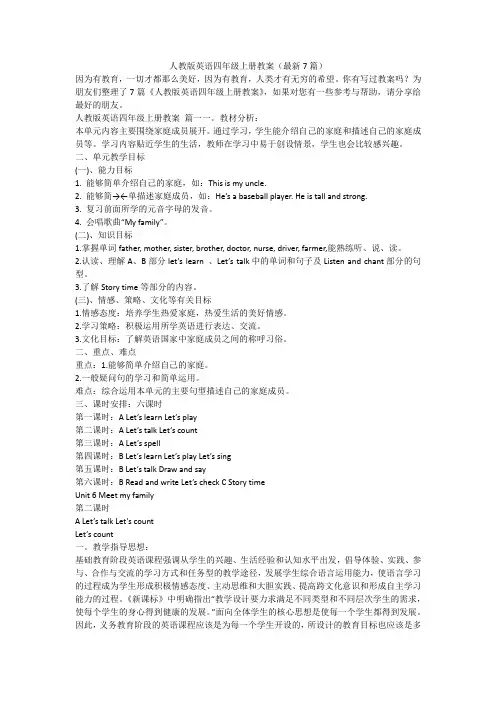
人教版英语四年级上册教案(最新7篇)因为有教育,一切才都那么美好,因为有教育,人类才有无穷的希望。
你有写过教案吗?为朋友们整理了7篇《人教版英语四年级上册教案》,如果对您有一些参考与帮助,请分享给最好的朋友。
人教版英语四年级上册教案篇一一。
教材分析:本单元内容主要围绕家庭成员展开。
通过学习,学生能介绍自己的家庭和描述自己的家庭成员等。
学习内容贴近学生的生活,教师在学习中易于创设情景,学生也会比较感兴趣。
二、单元教学目标(一)、能力目标1. 能够简单介绍自己的家庭,如:This is my uncle.2. 能够简→←单描述家庭成员,如:He’s a baseball player. He is tall and strong.3. 复习前面所学的元音字母的发音。
4. 会唱歌曲“My family”。
(二)、知识目标1.掌握单词father, mother, sister, brother, doctor, nurse, driver, farmer,能熟练听、说、读。
2.认读、理解A、B部分let’s learn 、Let’s talk中的单词和句子及Listen and chant部分的句型。
3.了解Story time等部分的内容。
(三)、情感、策略、文化等有关目标1.情感态度:培养学生热爱家庭,热爱生活的美好情感。
2.学习策略:积极运用所学英语进行表达、交流。
3.文化目标:了解英语国家中家庭成员之间的称呼习俗。
二、重点、难点重点:1.能够简单介绍自己的家庭。
2.一般疑问句的学习和简单运用。
难点:综合运用本单元的主要句型描述自己的家庭成员。
三、课时安排:六课时第一课时:A Let’s learn Let’s play第二课时:A Let’s talk Let’s count第三课时:A Let’s spell第四课时:B Let’s learn Let’s play Let’s sing第五课时:B Let’s talk Draw and say第六课时:B Read and write Let’s check C Story timeUnit 6 Meet my family第二课时A Let’s talk Let’s countLet’s count一。
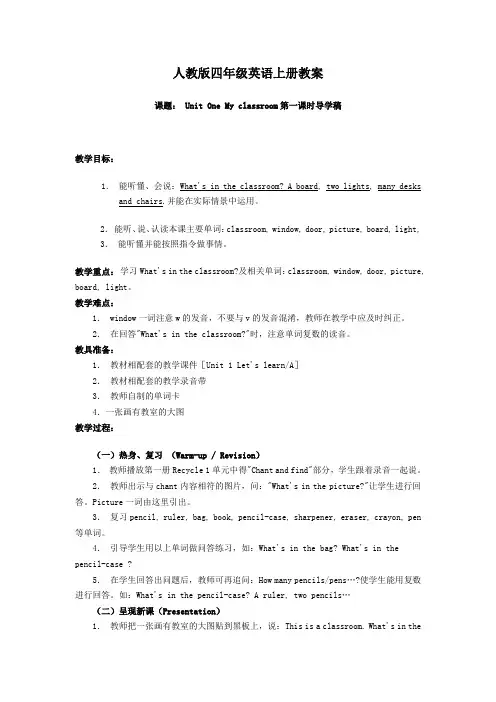
人教版四年级英语上册教案课题: Unit One My classroom第一课时导学稿教学目标:1.能听懂、会说:What's in the classroom? A board, two lights, many desks and chairs.并能在实际情景中运用。
2.能听、说、认读本课主要单词:classroom, window, door, picture, board, light, 3.能听懂并能按照指令做事情。
教学重点:学习What's in the classroom?及相关单词:classroom, window, door, picture, board, light。
教学难点:1. window一词注意w的发音,不要与v的发音混淆,教师在教学中应及时纠正。
2.在回答"What's in the classroom?"时,注意单词复数的读音。
教具准备:1.教材相配套的教学课件[Unit 1 Let's learn/A]2.教材相配套的教学录音带3.教师自制的单词卡4.一张画有教室的大图教学过程:(一)热身、复习(Warm-up / Revision)1.教师播放第一册Recycle 1单元中得"Chant and find"部分,学生跟着录音一起说。
2.教师出示与chant内容相符的图片,问:"What's in the picture?"让学生进行回答。
Picture一词由这里引出。
3.复习pencil, ruler, bag, book, pencil-case, sharpener, eraser, crayon, pen 等单词。
4.引导学生用以上单词做问答练习,如:What's in the bag? What's in thepencil-case ?5.在学生回答出问题后,教师可再追问:How many pencils/pens…?使学生能用复数进行回答。
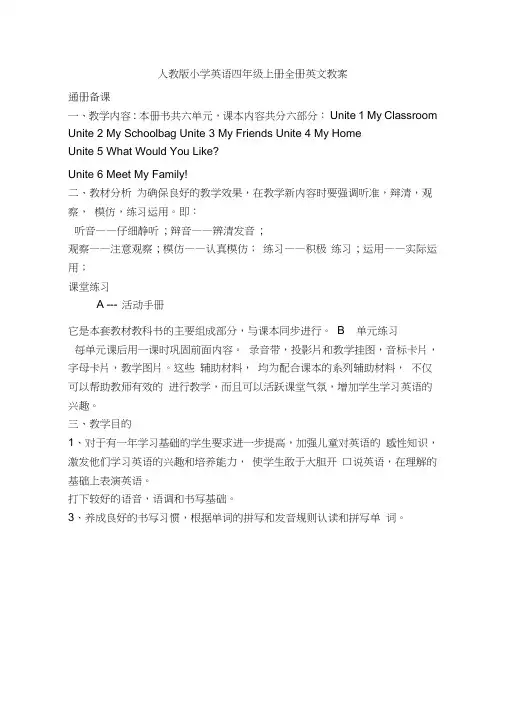
人教版小学英语四年级上册全册英文教案通册备课一、教学内容: 本册书共六单元,课本内容共分六部分:Unite 1 My Classroom Unite 2 My Schoolbag Unite 3 My Friends Unite 4 My HomeUnite 5 What Would You Like?Unite 6 Meet My Family!二、教材分析为确保良好的教学效果,在教学新内容时要强调听准,辩清,观察,模仿,练习运用。
即:听音——仔细静听; 辩音——辨清发音;观察——注意观察; 模仿——认真模仿;练习——积极练习; 运用——实际运用;课堂练习A --- 活动手册它是本套教材教科书的主要组成部分,与课本同步进行。
B 单元练习每单元课后用一课时巩固前面内容。
录音带,投影片和教学挂图,音标卡片,字母卡片,教学图片。
这些辅助材料,均为配合课本的系列辅助材料,不仅可以帮助教师有效的进行教学,而且可以活跃课堂气氛,增加学生学习英语的兴趣。
三、教学目的1、对于有一年学习基础的学生要求进一步提高,加强儿童对英语的感性知识,激发他们学习英语的兴趣和培养能力,使学生敢于大胆开口说英语,在理解的基础上表演英语。
打下较好的语音,语调和书写基础。
3、养成良好的书写习惯,根据单词的拼写和发音规则认读和拼写单词。
四、重点难点:1、“四会”单词的教学。
2、每一课的会话的表演。
四会单词的拼写。
五、教学进度表周次日期主要内容1 Unit 12 Unit 13 Unit 14 Unit 25 Unit 26 National Day7 Exam(unit 1-2)8 Unit 39 Unit 310 Recycle 111 Unit 412 Unit 413 Exam(3-4)14 Unit 515 Unit 516 Unit 617 Unit 618 Recycle 219 Generalrevision20 Terminal examUnit 1 单元分析一、教学内容1、本单元要求会听,说,认读的单词:window board light picture door floor classroomcomputer wall teacher 's desk fan what in the wehave new go where2、本单元要求会听,说的单词和词组:many our seat near classmate clean have a look good idea all right good job3、帮助学生在掌握单词的基础上造出句子,编出对话,学以致用。

人教版四年级英语上册教案全册教案4篇人教版四年级英语上册教案全册教案篇1新课标指出:基础教育阶段英语课程的目标是以学生语言技能、语言知识、情感态度、学习策略和文化意识的发展为基础,培养学生的综合语言运用能力。
教学目标的设定,遵循的是明确具体,可操作性的原则。
基于这样的认识,我确定以下教学目标:(1)知识目标:能够理解并朗读let’s read部分的对话;能完成书本中的排序练习。
(2)能力目标:学习“问路”及“指点方向”用语,并能在具体的情景中使用。
(3)情感目标:培养学生团结友爱、乐于助人的良好品质。
使学生愿意在小组活动中积极与他人合作、互相帮助、共同完成学习任务。
本课时是一堂阅读教学课,其中涉及到的词汇句型比较多,通过对教学目标以及六年级学生情况分析,我认为重难点应该这样把握:1.本课时的教学重点是能够听、说、认读Let’s read 部分的对话。
2.本课时的难点是能够理解对话中出现的新时态和指点路线的新语言,如:What are you going to do after school? Get off at the cinema .Then walk straight for three minutes.三、说教法新课程倡导任务型的教学模式,让学生在教师的指导下,通过感知、体验、实践、参与、合作等方式,实现任务的目标,感受成功。
在学习过程中进行情感和策略调整,以形成积极的学习态度,促进语言实际运用能力的提高。
同时英语课程要面向全体学生,注重素质教育,要关注每个学生的情感,激发他们学习英语的兴趣,帮助他们建立学习的成就感和自信心,使他们在学习的过程中发展综合语言运用能力,提高人文素养,培养创新精神。
基于以上认识,我以新课程为指导,以学生为主体,让学生通过游戏、对话、思考,观察等来体验语言,体验生活,体验学习的过程与快乐。
(1)情境法。
通过呈现地图创设问路情境,让学生在形象的语言环境中学习、运用新知。
人教版小学四年级英语上册教案(5篇)人教版小学四年级英语上册教案篇1第一课时教学重点:学习what’s in the classroom?及相关单词:classroom, window, door, picture, board, light。
教学难点:1. window一词注意w的发音,不要与v的发音混淆,教师在教学中应及时纠正。
2. 在回答“what’s in the classroom?”时,注意单词复数的读音。
教具准备:1. 教材相配套的教学课件[unit 1 let’s learn/a]2. 教材相配套的教学录音带3. 教师自制的单词卡4.一张画有教室的大图教学过程:(一)热身、复习 (warm-up / revision)1. 教师播放第一册recycle 1单元中得“chant and find”部分,学生跟着录音一起说。
2. 教师出示与chant内容相符的图片,问:“what’s in the picture?”让学生进行回答。
picture一词由这里引出。
3. 复习pencil, ruler, bag, book, pencil-case, sharpener, eraser, crayon,pen等单词。
4. 引导学生用以上单词做问答练习,如:what’s in the bag? what’s in the pencil-case ?5. 在学生回答出问题后,教师可再追问:how many pencils/pens…?使学生能用复数进行回答。
如:what’s in the pencil-case? a ruler, two pencils… (二)呈现新课(presentation)1. 教师把一张画有教室的大图贴到黑板上,说:this is a classroom. what’s in the classroom?2. 学生听懂后,教师可先试着让学生回答,能说出英文的学生给与表扬(desk, chair, picture都已学过),也可让学生用中文回答。
人教版小学英语四年级上册教案教案标题:人教版小学英语四年级上册教案教案目标:1. 通过本节课的学习,学生能够掌握四年级上册所学英语知识点和基本词汇。
2. 培养学生的听、说、读、写的能力,提高他们的英语交流能力。
3. 培养学生的英语学习兴趣,激发他们的学习动力。
教学重点:1. 学习并掌握本节课的新词汇和句型。
2. 培养学生的听力和口语表达能力。
教学难点:1. 学生能够运用所学知识进行简单的对话。
2. 学生能够正确使用新学的句型。
教学准备:1. 教材:人教版小学英语四年级上册教材。
2. 多媒体设备:投影仪、音频设备。
3. 教具:图片、卡片、小黑板。
教学过程:Step 1: Warm-up (热身活动)1. Greet the students and review the previous lesson by asking questions related to the previous lesson.2. Play a warm-up game, such as "Simon Says," to get the students engaged and focused on the lesson.Step 2: Presentation (呈现新知)1. Introduce the new vocabulary and sentence patterns for this lesson using visual aids, such as pictures or flashcards.2. Use real-life examples and gestures to help students understand the meaning of the new words and sentences.3. Practice pronunciation and intonation by repeating after the teacher.Step 3: Practice (练习)1. Divide the class into pairs or small groups and ask them to practice the new vocabulary and sentence patterns through role plays or conversations.2. Monitor the students' practice and provide guidance and feedback as needed.3. Encourage students to use the target language as much as possible.Step 4: Consolidation (巩固)1. Review the new vocabulary and sentence patterns through various activities, such as word games, matching exercises, or fill-in-the-blanks.2. Provide additional practice opportunities for students to reinforce their understanding and retention of the new material.Step 5: Assessment (评估)1. Assess students' understanding and progress by asking questions or assigning short written exercises.2. Provide individual feedback and address any misconceptions or difficulties. Step 6: Closure (课堂结束)1. Review the key points and main takeaways from the lesson.2. Assign homework to reinforce the lesson content and encourage independent learning.教学延伸:1. 利用多媒体资源,如英语学习网站或应用程序,为学生提供额外的学习资源和练习机会。
人教版四年级英语上册(全册)电子教案课程概述本教案是人教版四年级英语上册的电子教案,共包含全册的教学内容。
本教案旨在帮助四年级学生研究和掌握英语基础知识和语言技能。
教案中包括了每个单元的教学目标、教学步骤、教学资源以及评价方法。
教学目标本教案的教学目标主要包括:- 培养学生对英语的兴趣,激发研究动力;- 研究英语的基础知识,包括单词、语法、句型等;- 培养学生的听、说、读、写的综合语言能力;- 增强学生的交际能力,培养他们在实际生活中运用英语的能力。
教学步骤本教案按照每个单元的研究内容划分了教学步骤:1. 导入:通过简单的导入活动,预热学生的研究氛围,引发他们的兴趣;2. 研究:介绍新的知识点,通过教师讲解和学生练的方式,帮助学生理解和掌握知识;3. 练:通过不同形式的练,巩固和运用所学的知识;4. 拓展:提供一些额外的研究资源,让学生进行拓展练,提高他们的研究能力;5. 小结:总结本节课的重点内容,帮助学生巩固所学知识;6. 评价:根据学生的表现,给予适当的评价和反馈。
教学资源本教案提供了以下教学资源:- 课件:每个单元配备了相应的课件,帮助教师进行教学;- 练册:每个单元提供了练册,供学生进行课后练;- 听力材料:提供了相关的听力材料,帮助学生训练听力能力;- 教学素材:包括图片、视频等教学素材,让教学更加生动有趣。
评价方法本教案提供了多种评价方法,包括:- 口头评价:通过课堂互动、小组讨论等方式,进行口头评价;- 书面评价:通过练册、作业等书面形式,进行评价;- 听力评价:通过听力测试,评估学生的听力能力;- 个别评价:根据学生的个别表现,进行针对性的评价和反馈。
教案中的每个单元都按照上述教学目标、步骤、资源和评价方法进行设计,以帮助教师有效地进行课堂教学和学生的综合能力培养。
1 四英语 学科教学计划 (2017-2018)学年度第 一 学期
一、学情分析:
经过一年学习,四年级大部分学生对英语仍然保持着浓厚的兴趣,但有少数学生由于遇到困难,学习兴趣可能会开始减退,导致两极分化现象较为为严重,因此教学时应注意由简到难,循序渐进,在知识的复现中做好及时补差工作。使每位学生的英语水平都能得到一定的发展。
二、教材分析:
本册教材以话题为核心,以功能和结构为主线,以任务为目标,设计和编排了大量形式多样、情景真实、语言自然、趣味性强的语言实践活动,并着重综合训练,强调整体优化,突出整体感悟。 知识体系上贴近学生的生活实际,以真实生活表达为目的,以生活实际需求为线索,滚动编排和扩展所学语言知识。以 “用英语要做事情”为途径, 带动语言知识的内化和能力的转化;以 “做事”的效果为标准,检验知识运用的水平和等级。 内容上强调“培养综合语言运用能力” 开阔学生的学习视野,满足学生的求知欲望,引导学生面向社会,面向世界面向未来,不断增强国际意识。 框架上注重从语言形式主义向语言功能主义转变,着眼于 “语言运用” 。根据“话题项目表”确定话题的选择、话题的内容和名称以及次序的编排。 教学活动设计强调 “真实性”。基于意义的活动增加了,基于形式的活动减少了;互动的活动增加了,简单的练习减少了;活动方式更加丰富多样;语境设置更贴近生活。 本册书共8个单元和2个综合语言实践活动。每单元中的7个板块主次分明,脉络清晰,联系紧密: Story time通过课文学习,帮助学生学习基本的英语语言知识,发展基本的英语听、说、读技能。 Fun time通过趣味性、互动性较强的游戏活动,帮助学生操练并掌握本单元所学主要词语、句型和日常交际用语。 Cartoon time通过卡通故事,帮助学生强化本单元的语言知识,着重培养学生的阅读理解能力。
Sound time通过例词和绕口令,引导学生了解字母在单词中的读音、简单的拼读规则。 Song time/Rhyme time通过唱歌曲、诵歌谣等活动,激发学生的兴趣,帮助学生巩固所学内容,形成良好的语感,提高听说能力和思维能力。 2
Checkout time检测学生对本单元所学语言知识的掌握情况,同时帮助学生复习巩固所学主要内容,提高听、说、读、写能力。 Ticking time通过自我评价,引导学生了解自己对本单元所学内容的掌握情况。
三、教学目标: 1. 学生能按四会的要求掌握所学单词和句型。 2. 学生能在日常生活中活用句型,进行简单交流,尽量做到落落大方,发音纯正。 3. 学生逐渐养成良好的语音语调。 带, 4. 学生能借助光盘、磁带等辅助工具听读课文,养成良好的预习、复习习惯,并有一定的自学能力。 5. 学生能在任务型学习的过程中运用相关的语言知识,完成某项特定任务,并促进运用语言能力的提高。 6. 学生能演唱已学过的英语歌曲,朗诵已学过的歌谣。部分学生能大胆设计,创新歌曲、歌谣。在完成任务的过程中,不断感受成功的乐趣和喜悦。 7.学生能听懂、会说辅音字母在单词中的读音,且发音正确。 8. 初步养成良好的书写习惯,做到书写规范整洁。 9. 训练学生的语言技能,提高阅读理解能力。 10. 悉心指导学生,逐步培养学生的自我评价能力。
四、具体措施: 1、坚持“先学后教”的理念,抓好预习和作业,实行分层教学、分层作业,教师及时地进行检查,让每个学生得到不同层次的提高和发展。 2、创设学习英语的情景,把重点句型放在情景中教学,采用灵活多样的教学方式,营造轻松和谐的课堂氛围,让学生快乐地学习知识。 3、设计全面、高效的课外作业,培养学生良好的书写习惯,做到整洁、规范、正确地书写。 4、活用教材,根据学生会的实际情况,将每单元重现组排降低难度。 5. 重视学生英语朗读训练,打好纯正语音语调的基础。 3
Unit 1 课题 I like dogs 第 1 课时 教学目标 1、语言知识: 1.能初步听懂、会读、会拼写单词cat, dog,elephant,horse, lion,monkey, panda,tiger 2.能听懂、会说、会读、会运用句型Do you like…?并且会用Yes, I do.和No,I don’t 来回答。 思考调整
2、语言技能: 能明白并理解名词的复数形式,理解like的后面用可数名词的复数形式 3、情感态度: 情感教育:动物是人类的好朋友,要保护动物 教学重点 1.能初步听懂、会读、会拼写单词cat, dog, elephant, horse, lion, monkey, panda, tiger 2.能听懂、会说、会读、会运用句型Do you like…?并且会用Yes, I do.和No,I don’t 来回答。 3.能明白并理解名词的复数形式,理解like的后面用可数名词的复数形式
教学难点 让学生综合过去所学知识,明白like后面使用可数名词的复数形式 课前准备 挂图,卡片,多媒体 教学过程 Step 1 Preparation 1. Greeting 2. Free talk T:Welcome back to school. Are you happy now? S: Yes, I am. T: Let’s enjoy our English lessons now. What can you see in our classroom? 通过这个环节让学生提前进入学习英语的氛围中。
Step 2 Presentation and practice 1. T: I have a toy dog. I like dogs .(出示各种动物图) S:I like… 根据学生的回答学习单词:cat ,dog, monkey, lion, panda, tiger, bear。(学生带读,板书单复数。) cat[kæt] dog[dɒɡ] monkey['mʌŋkɪ] lion['laɪən] panda[ˈpændə] tiger[ˈtaɪgə(r)] 2.T: I like dogs .Do you like dogs? 4
S: Yes, I do./No, I don’t. T: What do you like? S: I like … 出示句型: Do you like…? Yes, I do. No, I don’t.I like… 3.观察句子Do you like…? I like… (1)提出疑问(为什么like后面要跟复数,跟单数行不行?) (2)小组讨论得出结论:like 表示喜欢一类事物。 4教授单词animal/animals T: Look, the cat is an animal.It’s an animal. How lovely. 出示单词animal,拼读单词。[ˈæ nIml]出示音标。 T:They are all animals.They’re animals. 出示单词animals,拼读单词。 T:Do you like animals? S: Yes, Ido. T:I like animals too.Now, let’s listen to the sounds. Guess, what animal is it. 听声音猜猜是什么动物。
Step 3 Production Listen and guess (1)Magic eyes T:Now,let’s have a rest.Let’s play a game. 游戏规则:快速闪现图片、单词、词组、或者句子 例如: 单词: a cat , an elephant, a duck… dogs, tigers, pandas… 词组: a toy animal , would like, like monkeys… 句子: I like dogs. I have two books, walk up and down, what colour is it?… (2)Work in pairs T: I have some pictures here. Choose one to work in pairs.
Step 4 Progress 让学生说说这节课学了什么,让学生自己来总结。 A.复习单词 B.复习句型 C.复习知识点like后面使用可数名词的复数形式 Step 4 Homework
教后反思 5
Unit 1 课题 I like dogs. 第 2 课时 教学目标 1、语言知识: 1.能熟练掌握动物类单词。 2. 能听懂、会说、会读、会运用句型Do you like…?并且会用Yes, I do.和No,I don’t 来回答。 3.能有感情的朗读课文,能初步分角色表演。 思考调整
2、语言技能: 能在情景中自然、流利地使用句型Do you like…?并且会用Yes, I do.和No,I don’t 来回答。
3、情感态度: 培养学生关爱动物的品质 教学重点 1. 能自然、流利地使用句型Do you like…?并且会用Yes, I do.和No,I don’t 来回答。 2. 能初步使用交际用语。It’s cute. They are cute and fat.
教学难点 能有感情的朗读课文,能初步分角色表演。 课前准备 图片、录音机、玩具动物 教学过程 Step 1 Preparation 1. Greetings. 2. Daily talk. 3.Ticking time :I can name some animals.
Step 2 Presentation and practice Story time
出示课文图片 T:Look,they are our friends. They are talking about animals. (1)Listen and circle(把所看到的动物圈出来) What animals can you see in the story?
Cats dogs elephants horses lions monkeys pandas tigers 在看动画之前,先读单词(复习单数和复数):an elephant,a horse(elephants , horses) elephant[ˈelɪfənt] horse[hɔ:s] Check the answers: cats , dogs, pandas (2)True or false Yang Ling: I like cats. They are cute.(√) 教授单词cute(可爱的,机灵的) Su Hai: I don’t like dogs. I like horses.(×) Mike: I don’t like dogs. I like pandas.(√)